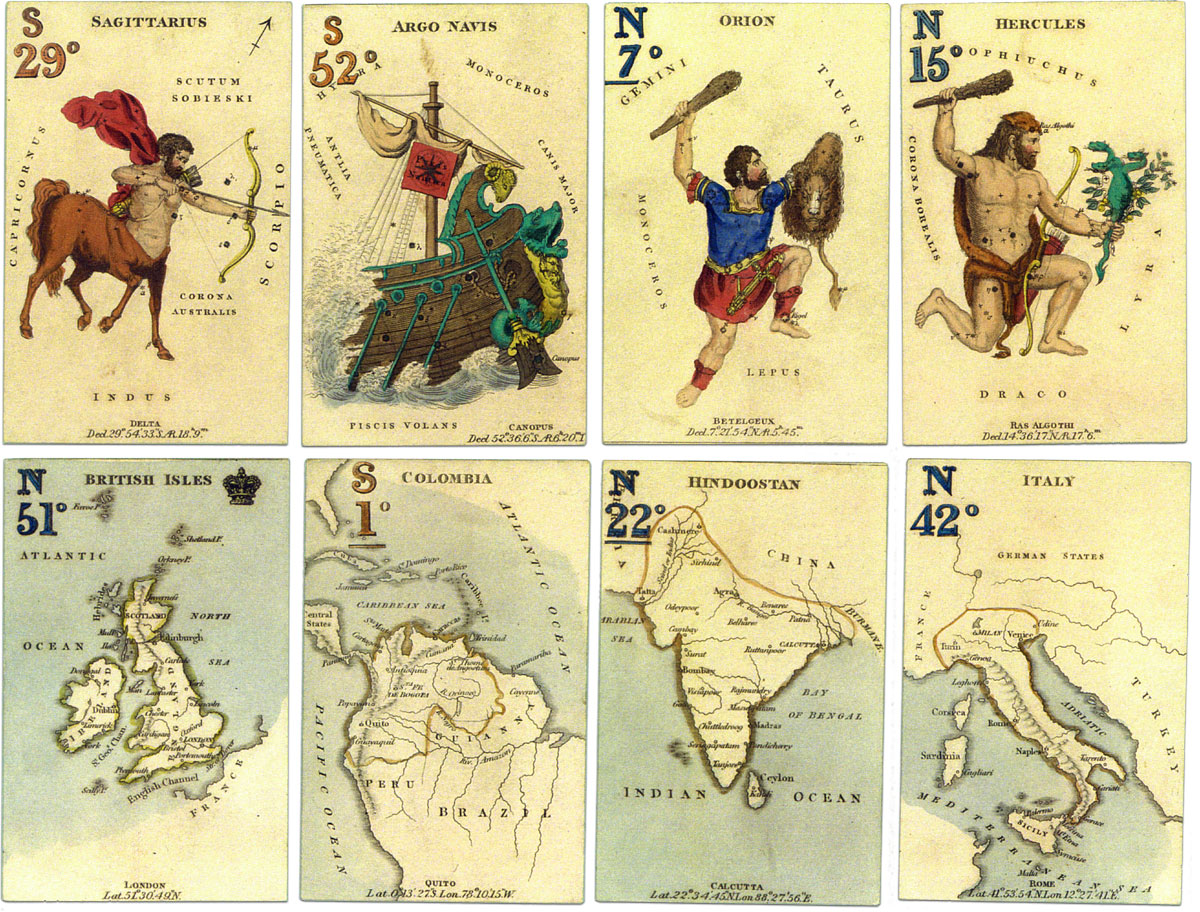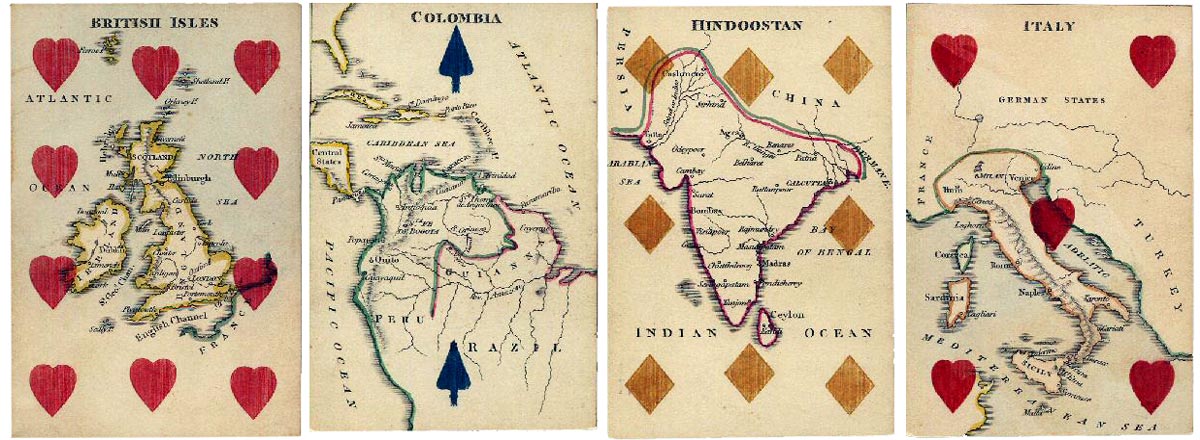Charles Hodges
Charles Hodges produced engraved geographical and astronomical decks, London, c.1827-30.
Above: Charles Hodges' Geographical cards were originally published in 1827. The Aces carry maps of the four continents; the court cards depict historical persons representing the four continents and the other numeral cards show maps of the respective countries. The aces of Spades Hearts, Diamonds and Clubs respectively represent the Americas, Europe, Asia and Africa. George Washington appears as the King of Spades and King George IV as the King of Hearts. A magnificent Chinese Emperor appears as the King of Diamonds. These maps from the numeral cards were re-used for the Astrological cards shown below. The images above are from a facsimile edition of cards in the Cary Collection at Yale University. Images courtesy Rod Starling.
Charles Hodges operated as a bookseller and stationer at 27 Portman Street, Portman Square, London, from 1825-6 until 1830. Following the tradition of engraved pictorial playing cards depicting educational, scientific and other subjects, which had its heyday in England during the 17th-18th centuries, Hodges published these Geographical and Astronomical packs starting in around 1827. The Geographical cards (shown above) were probably inspired by a pack made in France by René Janet in 1825 called “Boston de l'Univers ou Jeu des quatre parties du Monde”. The English version is believed to have been made for Hodges by Stopforth & Son in London. The Astronomical pack (shown below) was also likely made by Stopforth & Son. These are amongst the last of the finely engraved English packs as chromolithography was soon to take over.
Astrophilogeon, c.1828
Hodges' companion pack dealing with astronomy had numeral cards carrying diagrams of constellations and their pictorial representations; the court cards represent classical deities. The aim of the game was to obtain pairs of map and constellation cards from similar parts of the terrestrial and celestial globes. Information about the locality was printed at the bottom of the cards and the latitude or declination was displayed as a corner index at the top left under a large 'N' or 'S'. The maps which were used in the Geographical cards were again re-used, without any suit signs stencilled in, to complete the Astrophilogeon decks.

Above: Astrophilogeon, c.1828, made for Charles Hodges by Stopforth & Son. The basic aim of the game was to obtain pairs of map and constellation cards from similar parts of the terrestrial and celestial globes. The maps used in the Geographical cards with stencilled pips (below) were re-used in the Astrophilogeon decks (above) with the extra information over-printed from a second plate.

Hodges had published supplementary sets of 40 map or constellation cards with no suit signs or other information printed on them, or accompanying court cards, as New Geographical Cards and New Astronomical Cards, and was able to re-use the same plates for both his Geographical and Astrophilogeon decks with the additional information over-printed from separate plates or stencils. After Hodges ceased trading in c.1830 the packs were re-issued in 1838-9 by William and Henry Rock possibly, at first, using the same plates but subsequently moving to lithographic printing.
REFERENCES
Berry, John: Hodges' Artful Dodges, in "The Playing-Card", vol.30, no.2, Sept/Oct 2001.
Mann, Sylvia: All Cards on the Table, Jonas Verlag/Deutsches Spielkarten-Museum, Leinfelden-Echterdingen, 1990
See also: Robert Morden's Map cards, 1676 • Knavery of the Rump, 1679 • Arms of English Peers, 1688 • Mechanical instruments, c.1700 • Marlborough's Victories, 1707 • Fortune-Telling Cards, c.1714 • South Sea Bubble, 1720 • The Beggar's Opera, 1728 • Cries of London, 1754 • Transformation Cards, 1811 • Imperial Royal pack, 1828

By Simon Wintle
Member since February 01, 1996
I am the founder of The World of Playing Cards (est. 1996), a website dedicated to the history, artistry and cultural significance of playing cards and tarot. Over the years I have researched various areas of the subject, acquired and traded collections and contributed as a committee member of the IPCS and graphics editor of The Playing-Card journal. Having lived in Chile, England, Wales, and now Spain, these experiences have shaped my work and passion for playing cards. Amongst my achievements is producing a limited-edition replica of a 17th-century English pack using woodblocks and stencils—a labour of love. Today, the World of Playing Cards is a global collaborative project, with my son Adam serving as the technical driving force behind its development. His innovative efforts have helped shape the site into the thriving hub it is today. You are warmly invited to become a contributor and share your enthusiasm.
Related Articles

Scientific Whist
“Scientific Whist” : standard cards with instructions for play on the faces by Chas Goodall & Son, 1...

Agent Provocateur
Branded lingerie collection in a pack of pin-up playing cards.

Nimbus playing cards
Mike Steer’s weather-themed pack with suits in four colours and backs for cardistry.

Agatha Christie and Playing Cards revisited
Agatha Christie uses card-play as a primary focus of a story, and as a way of creating plots and mot...

The Decadent Deck
Studies in the eroticism of the female body by Inge Clayton.

Historic Shakespeare
“Historic Shakespeare” playing cards featuring Shakespearean characters by Chas Goodall & Son.

Copechat Paramount Sorting System
Preserving the past: a specimen deck showcasing edge-notched cards and their ingenious sorting syste...

Heartsette by Herbert Fitch & Co, 1893
A glimpse into a busy print and design office in late Victorian London.

German Travel Cards
A travel-themed educational deck helping American tourists visiting Germany.

Batman® playing cards
Batman playing cards published by InterCol of London 1989.

Can You Believe Your Eyes?
“Can You Believe Your Eyes?” playing cards featuring visual illusions & other oddities.

Pastime Playing Cards for the Blind
The “Pastime” Playing Cards for the Blind manufactured by Goodall & Son Limd., c.1910.

An Anonymous Belgian Transformation Pack
Anonymous Belgian transformation pack borrowing many images from earlier designs by Braun & Schneide...

Songs with Flute accompaniment
Eighteenth century English engraved cards with music for voice and flute.

Love Tests
Vintage novelty “Love Test” cards of a slightly saucy nature but all in good fun!

The Game of the Gods
Figures and symbols from Norse mythology, designed by Barbro Gustafsson and Inga Lundström.
Most Popular
Our top articles from the past 28 days







